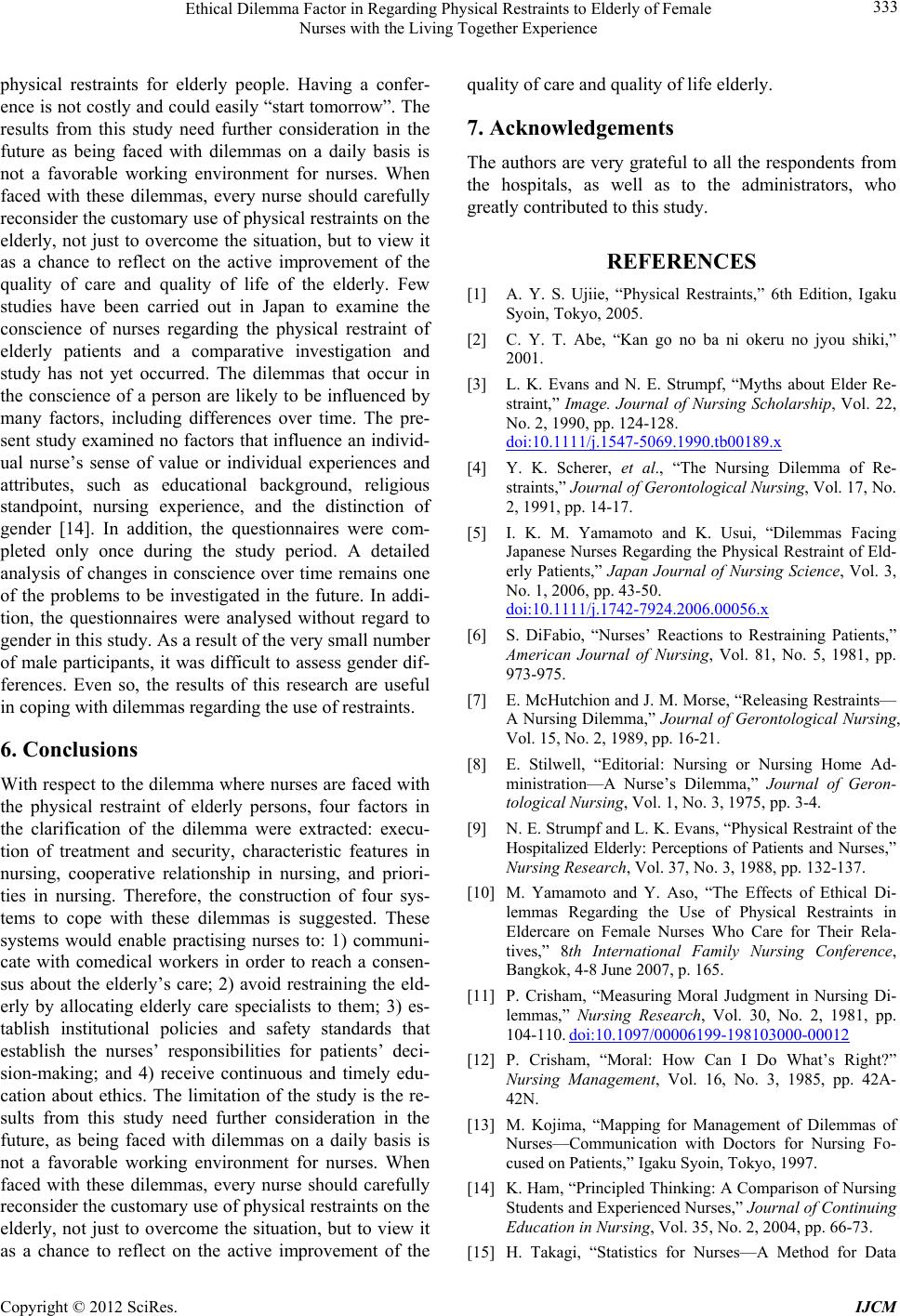
Ethical Dilemma Factor in Regarding Physical Restraints to Elderly of Female
Nurses with the Living Together Experience 333
physical restraints for elderly people. Having a confer-
ence is not costly and cou ld easily “start tomorrow”. The
results from this study need further consideration in the
future as being faced with dilemmas on a daily basis is
not a favorable working environment for nurses. When
faced with these dilemmas, every nurse should carefully
reconsider the customary use of physical restraints on the
elderly, not just to overcome the situation, but to view it
as a chance to reflect on the active improvement of the
quality of care and quality of life of the elderly. Few
studies have been carried out in Japan to examine the
conscience of nurses regarding the physical restraint of
elderly patients and a comparative investigation and
study has not yet occurred. The dilemmas that occur in
the conscience of a person are likely to be influenced by
many factors, including differences over time. The pre-
sent study examined no factors that influence an individ-
ual nurse’s sense of value or individual experiences and
attributes, such as educational background, religious
standpoint, nursing experience, and the distinction of
gender [14]. In addition, the questionnaires were com-
pleted only once during the study period. A detailed
analysis of changes in conscience over time remains one
of the problems to be investigated in the future. In addi-
tion, the questionnaires were analysed without regard to
gender in this stu dy. As a result of the very small n u mber
of male participants, it was difficult to assess gender dif-
ferences. Even so, the results of this research are useful
in coping with dilemmas regarding the use of restraints.
6. Conclusions
With respect to the dilemma where nurses are faced with
the physical restraint of elderly persons, four factors in
the clarification of the dilemma were extracted: execu-
tion of treatment and security, characteristic features in
nursing, cooperative relationship in nursing, and priori-
ties in nursing. Therefore, the construction of four sys-
tems to cope with these dilemmas is suggested. These
systems would enable practising nurses to: 1) communi-
cate with comedical workers in order to reach a consen-
sus about the elderly’s care; 2) avoid restraining the eld-
erly by allocating elderly care specialists to them; 3) es-
tablish institutional policies and safety standards that
establish the nurses’ responsibilities for patients’ deci-
sion-making; and 4) receive continuous and timely edu-
cation about ethics. The limitation of the study is the re-
sults from this study need further consideration in the
future, as being faced with dilemmas on a daily basis is
not a favorable working environment for nurses. When
faced with these dilemmas, every nurse should carefully
reconsider the customary use of physical restraints on the
elderly, not just to overcome the situation, but to view it
as a chance to reflect on the active improvement of the
quality of care and quality of life elderly.
7. Acknowledgements
The authors are very grateful to all the respondents from
the hospitals, as well as to the administrators, who
greatly contributed to this study.
REFERENCES
[1] A. Y. S. Ujiie, “Physical Restraints,” 6th Edition, Igaku
Syoin, Tokyo, 2005.
[2] C. Y. T. Abe, “Kan go no ba ni okeru no jyou shiki,”
2001.
[3] L. K. Evans and N. E. Strumpf, “Myths about Elder Re-
straint,” Image. Journal of Nursing Scholarship, Vol. 22,
No. 2, 1990, pp. 124-128.
doi:10.1111/j.1547-5069.1990.tb00189.x
[4] Y. K. Scherer, et al., “The Nursing Dilemma of Re-
straints,” Journal of Gerontological Nursing, Vol. 17, No.
2, 1991, pp. 14-17.
[5] I. K. M. Yamamoto and K. Usui, “Dilemmas Facing
Japanese Nurses Regarding the Physical Restraint of Eld-
erly Patients,” Japan Journal of Nursing Science, Vol. 3,
No. 1, 2006, pp. 43-50.
doi:10.1111/j.1742-7924.2006.00056.x
[6] S. DiFabio, “Nurses’ Reactions to Restraining Patients,”
American Journal of Nursing, Vol. 81, No. 5, 1981, pp.
973-975.
[7] E. McHutchion and J. M. Morse, “Releasing Restrain ts—
A Nursing Dilemma,” Journal of Gerontological Nursing,
Vol. 15, No. 2, 1989, pp. 16-21.
[8] E. Stilwell, “Editorial: Nursing or Nursing Home Ad-
ministration—A Nurse’s Dilemma,” Journal of Geron-
tological Nursing, Vol. 1, No. 3, 1975, pp. 3-4.
[9] N. E. Strumpf and L. K. Evans, “Physical Restraint of the
Hospitalized Elderly: Perceptions of Patients and Nurses,”
Nursing Research, Vol. 37, No. 3, 1988, pp. 132-137.
[10] M. Yamamoto and Y. Aso, “The Effects of Ethical Di-
lemmas Regarding the Use of Physical Restraints in
Eldercare on Female Nurses Who Care for Their Rela-
tives,” 8th International Family Nursing Conference,
Bangkok, 4-8 June 2007, p. 165.
[11] P. Crisham, “Measuring Moral Judgment in Nursing Di-
lemmas,” Nursing Research, Vol. 30, No. 2, 1981, pp.
104-110. doi:10.1097/00006199-198103000-00012
[12] P. Crisham, “Moral: How Can I Do What’s Right?”
Nursing Management, Vol. 16, No. 3, 1985, pp. 42A-
42N.
[13] M. Kojima, “Mapping for Management of Dilemmas of
Nurses—Communication with Doctors for Nursing Fo-
cused on Patients,” Igaku Syoin, Tokyo, 1997.
[14] K. Ham, “Principled Thinking: A Comparison of Nursing
Students and Experienced Nurses,” Journal of Continuing
Education in Nursing, Vol. 35, No. 2, 2004, pp. 66-73.
[15] H. Takagi, “Statistics for Nurses—A Method for Data
Copyright © 2012 SciRes. IJCM